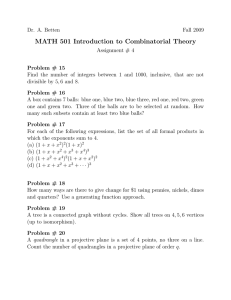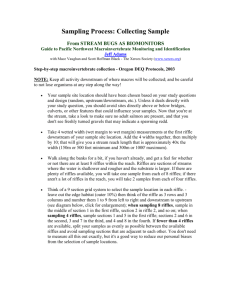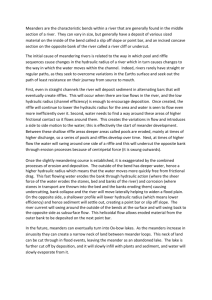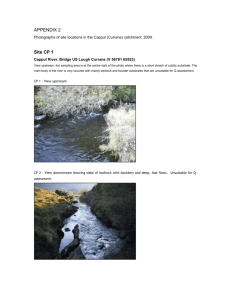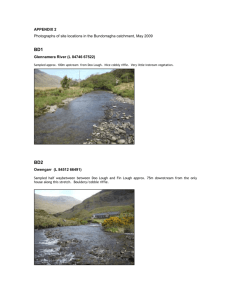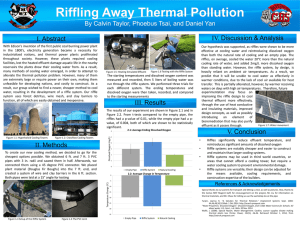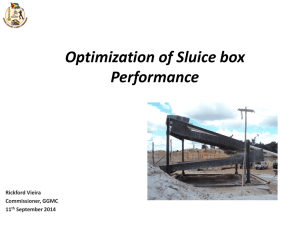A comparison of riffle insect populations in the Gibbon River... Yellowstone National Park
advertisement
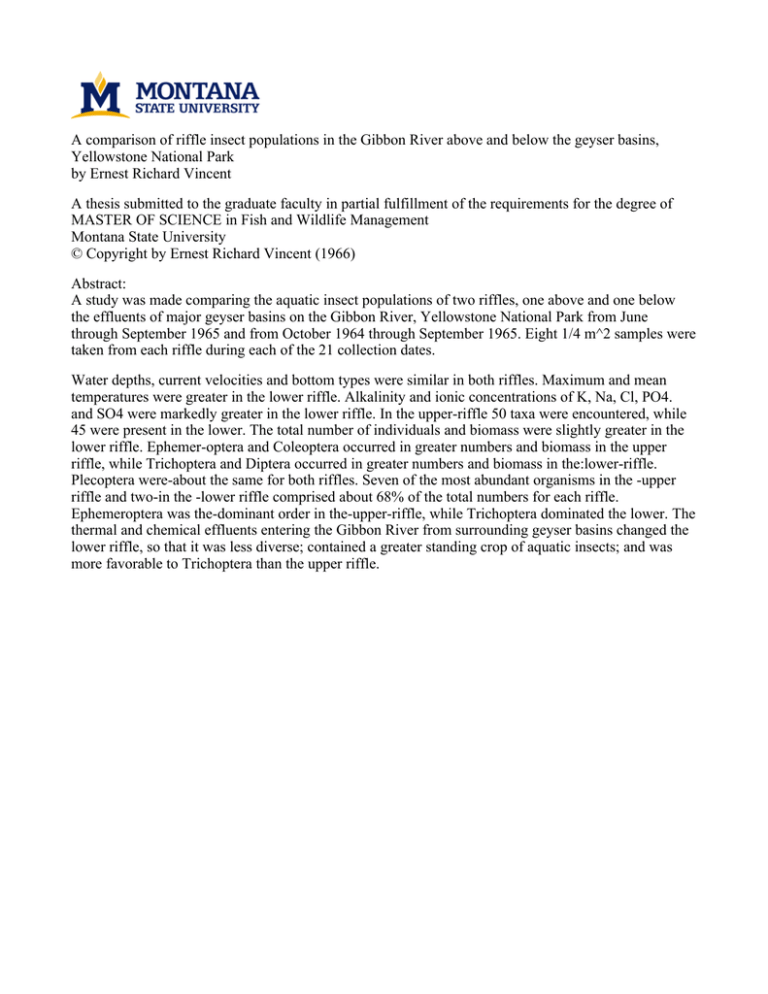
A comparison of riffle insect populations in the Gibbon River above and below the geyser basins,
Yellowstone National Park
by Ernest Richard Vincent
A thesis submitted to the graduate faculty in partial fulfillment of the requirements for the degree of
MASTER OF SCIENCE in Fish and Wildlife Management
Montana State University
© Copyright by Ernest Richard Vincent (1966)
Abstract:
A study was made comparing the aquatic insect populations of two riffles, one above and one below
the effluents of major geyser basins on the Gibbon River, Yellowstone National Park from June
through September 1965 and from October 1964 through September 1965. Eight 1/4 m^2 samples were
taken from each riffle during each of the 21 collection dates.
Water depths, current velocities and bottom types were similar in both riffles. Maximum and mean
temperatures were greater in the lower riffle. Alkalinity and ionic concentrations of K, Na, Cl, PO4.
and SO4 were markedly greater in the lower riffle. In the upper-riffle 50 taxa were encountered, while
45 were present in the lower. The total number of individuals and biomass were slightly greater in the
lower riffle. Ephemer-optera and Coleoptera occurred in greater numbers and biomass in the upper
riffle, while Trichoptera and Diptera occurred in greater numbers and biomass in the:lower-riffle.
Plecoptera were-about the same for both riffles. Seven of the most abundant organisms in the -upper
riffle and two-in the -lower riffle comprised about 68% of the total numbers for each riffle.
Ephemeroptera was the-dominant order in the-upper-riffle, while Trichoptera dominated the lower. The
thermal and chemical effluents entering the Gibbon River from surrounding geyser basins changed the
lower riffle, so that it was less diverse; contained a greater standing crop of aquatic insects; and was
more favorable to Trichoptera than the upper riffle. A COMPARISON.OF RIFFRE.INSECT POPULATIONS IN THE GIBBON RIVER -ABOVE AND
BELOW THE GEYSER BASINS, YELLOWSTONE NATIONAL PARK
by
ERNEST RICHARD VINCENT
A thesis submitted to the graduate faculty in partial
fulfillment of the requirements for the degree
of
MASTER OF SCIENCE
in
Fish and Wildlife Management
Approved:
Cha^pfm a n 9 Examining Committee
MONTANA STATE UNIVERSITY
Bozeman, Montana
June, 1966
iii
A CKNOWLEDGEMENTS
The writer wishes t o ■extend gratitude to all who helped in the course
of this study.
Dr, C. J, D. Brown directed the study and assisted in pre­
paring the thesis,
Dr,. E, J, Graham gave valuable suggestions and field
assistance along with Jack .Heaton, George Algard and Al Elser,
did t h e •chemical analysis of the water samples,
thermograph temperature data.
Ted Boeder
Elston Todd furnished
Sincere appreciation for the identification
of the aquatic insects is extended to Dr, Arden' R, Gaufin (Rlecoptera),
O 0 S, Flint (Trichoptera) and Steve Jensen (Ephemeroptera) 0
cooperation was received from the National Park Service,
Excellent
This research
was supported by the Public Health-Service through Dr,- John C, Wright,
Training Grant No- $T1 -WP-I and Research Grant No, WPr-00125 from the
Division of Water Supply and Pollution Control,
iv
• TAHCiE-OF CONTENTS
Page
VITA
O
O
° ° ° °
ACKNOWLEDGEMENTS
O
O
• e
LIST OF TABLES . . . . . .
O
O
LIST.OF FIGURES
a
o
° ° ° °
ABSTRACT
O
O
° Q •
INTRODUCTION . . . . . . .
O
O
°
METHODS
. . . . . . . . .
O
O
DESCRIPTION-. OF STUDY AREA.
O
O
RESULTS
o
a
P
O
o
o
o
o
o
o
o
o
e
o
o
o
o
o
o
. V . . .
o
o
o
o
o
Distribution of Taxa.
°
ii
O
° ° ° °
iii
O
O.
• ° ° •
V
° °
O
O
°
° °
vi
O
° °
O
O
° ° ° °
vii.
O
O
°
O
O
° ° ° °
I
®.6
O
O
° °
O
O
° ° °
2
O
O
O
° °
O
O
° ° ° °
3
O
O
9
°
O
O
° *° ° °
8
O
O
° ?
O
O
° ° ° °
8
O O
8
°
•
O
O
° °
a
a
O
O
° •
O
° ° ° • ° ° "® °
O
O
° 0
° ° °
O
O
° ° ° °
O
° °
° ° ° ° °
° ° ° ° ° °
° ° °
■° °
° ° ° ° ° ° °
° ° ° °
° °
o,
°
Comparison .o f ■Numbers and Biomass ■of Aquatic Insects
Ephemeropt era
.o
o o p o o o o o o o o o o q o
,O
O
O
o o o o o
11
PleCOpt era
o
o
o
o
o
o
o
o
o
o
o
o
o
o
o
o
o
o
o
o
o
o
o
12
Coleoptera
o
o
o
o
o
o
o
o
o
o
o
o
o
o
o
o
o
o
o
o
o
o
o
13
O
O
O
O
O
O
O
O
O
O
O
O
O
O
O
O
O
O
O
O
O
O
13
o
o
o
o
o
o
14
Triehoptera
■Bxptera
o
o
o
o
o
o
o
o
o
o
o
’o
o
o
o
o
o
o
Comparison of Aquatic -Insect Orders in.-the Study Riffles
DISCUSSION
O.
O
O
O
LITERATURE CITED
O
O
o
o
O'
O
O
o
o
o
O
o
•O
O
o
o
o
o
O
o
O
o
0 . 0
o
o
O
O
o
o
O
o
O
o
O
o
O
o
O
o
O
o
„ «
O
o
O
o
O
o
15
16
19
V
LIST :0F TABLES
-Page
It
2
«
Physical and chemical factors at each study riffle
Total .numbers per -m and volumes of a/qyatic -insects in the
■upper (U) and lower (L) study riffle? for each sampling
p
■3°
5
e
r
i o
d
O
O
O
O
O
O
O
O
O
O
O
O
O
O
O
O
O
O
O
O
O
i
9-4.0
O
Relative abundance and relative biomass for•each-aquatic in­
sect order■expressed as percent of total number-and biomass
Q
O
o
I
o
o
o
e
o
o
o
o
o
o
o
o
e
o
o
o
e
o
o
o
o
o
Q
o
16
vi
LIST 'OF'FIGURES
Page
I.
4
Study area
Seasonal fluctuations in water'temperature during the study
p
e
r
i o
d
O
O
O
O
O
O
O
O
O
Q
O
O
O
O
O
O
O
O
O
O
O
O
O
O
O
O
O
7
vii
ABSTRACT
A study was made comparing'-the aquatic insect populations of two
riffles, one above and one below t h e ■effluents■of major•geyser basins on
the Gibbon River, Yellowstone National Park from June through September
1965 and from October 1964 through September 1965« Eight 1A- m^ samples
were taken from each riffle during each of the 21 collection dates.
Water depths, current velocities and bottom types were similar in both
riffles. Maximum and mean temperatures were greater in the lower riffle.
Alkalinity and ionic concentrations of K, Na, Cl, POil.,and SO4 were marked­
ly greater in the lower riffle.
In the upper-riffle 50 taxa were en­
countered, while 45 were present in the lower. The total number of indi­
viduals and biomass were slightly greater in the lower riffle. Ephemeroptera and Coleoptera occurred in greater numbers and biomass in the upper
riffle, while Trichoptera and Diptera occurred in greater numbers and bio­
mass in t h e :lower-riffle. Plecoptera were-about the same for both riffles.
Seven of the most abundant organisms in the -upper riffle and two -in the
-lower riffle comprised about 68 # of the total numbers for each riffle.
Ephemeroptera was the-dominant order in the-upper-riffle, while Trichoptera
dominated the lower. The thermal and chemical effluents entering the
Gibbon River from surrounding geyser basins changed the lower riffle, so
that it was less diverse; contained a.greater standing crop of aquatic
insects; and was more favorable to Trichoptera than the upper riffle.
INTRODUCTION
A study■was done-on the -Insect populations of two riffles in the
■Gibbon River in the west-centra,! part of Yellowstone National Park dpring
19635 1964 and 1 9 6 5 «
One riffle was located above the effluents of the
major geyser basins and the other one below«
Some earlier studies showed
the influence of geyser water -on aquatic invertebrates in Yellowstone
National Park.
Armitage (1958) correlated temperature and alkalinity with
average annual standing crops of aquatic insects in the Firehole .River,
Gardiner River and Lava Creek.
Muttkowski (1929) did some descriptive
work on the ecology of aquatic insects in various streams.
Brues (1924)
made a few general observations on aquatic organisms in various thermal
areas.
A considerable amount of work has-been done concerning the effect of
temperature■on aquatic insect populations.
Dodds and Hisaw (1925) at­
tributed aquatic insect altitudinal zonation to temperature differences.
Ide (1935) found that the increase in the number of mayfly species down­
stream was due to the-higher temperatures which exist in the lower-regions
of the -Nottawasga River system.
Sprules (194?) reported a direct corre­
lation between the total change of species- at successive stations and the
average summer water temperature-in a study on the =Madawaska River,
Ontario, Canada.
Coutant (1 9 6 2 ) stated that during the hot summer months
■there■was a decrease,in number, diversity and total biomass of a macro­
invertebrate riffle population which was in the path of a heated water
effluent from a steam electric plant on the Delaware River, Pennsylvania.
-2METHODS
Bottom samples were taken with a net patterned after t h e ■Surber
2
Sampler0
It.had a square frame which enclosed an area of 1
A m
collecting n e t 'with 7=9 meshes/cm0
A total of 42 collections, two on each
sampling date, were taken during t h e ■study period,
of eight 1
A m
date.
and a .nylon
A collection consisted
samples of bottom materials from each riffle on a sampling
These were taken as follows:
every two weeks from 26 June to 26
September 1963 and in October 1964; once a month from November 1964 to
February 1965; and every two weeks ip April 1965 and from I July to 15
September 1965= -No collections were made during March 1965 because roads
were impassable or during May and June because of high water from the
spring runoff.
Collections were preserved in 5% formalin immediately
after being taken.
Aquatic organisms were sorted and preserved in 70%
alcohol in the laboratory.
They were classified to order and to-lesser
categories including species when practical.
each category was counted.
The number of individuals in
Volume to ■the nearesX)",! ml was determined by
displacement in 70% alcohol.
The term biomass is used for total volumes.
The volumes in milliliters are approximately equal to grams damp weight.
Four 1
A m
samples of bottom .materials were collected in each riffle
with a sampling net having 50 meshes/cm.
Materials were dried and put
through a series of Tyler soil screens to separate different sizes of
material.
T h e ■volume of each material size class was determined by dis­
placement in water and its percent of the total was calculated.
All
material was then placed in one of three major categories and one of seven
minor size groups as follows:
rubble-2, gravel-2 and sand-3=
Volumes of
-3the different size classes-of bottom .materials from both study riffles
w e r e ■compared statistically.by -using a two-way analysis-of variance test
using the seven minor size groups, except- for the largest (127 -3 0 5 'mm)
which was not adequately-sampled.
Eight discharge -measurements were-com­
puted for-each riffle-during the period .of study b y ;using average current
velocity, mean depth, and channel width.
with -a Gurley-Current-Meter,
Current velocities were secured
Temperature -measurements were taken with
maximum-minimum thermometers placed in-each riffle and.read on each
sampling date.
These thermometers were accurate-to-the nearest-0.5C.
Mean temperatures were computed to -the-nearest degree from maximum and
minimum temperature readings between sampling periods,
■used t o ■check mean temperatures.
eack sampling date,
A thermograph was
Methyl orange alkalinities were taken on
pH values were secured on two dates using the Beckman
Model G pH Meter,
DESCRIPTION OF STUDY AREA
The-Gibbon River originates.in Grebe lake at an elevation of 244? m
(8028 ft) m,s.l. and flows 4? km .in a southwesterly direction .to-join the
Firehole.River at an elevation .of 2075 m (6 8 0 6 ■ft).
The upper study
riffle■was approximately -7 km above and the .-lower study riffle-was l 8 km
below-the-entrance of major geyser effluents.
The river above the upper
study -riffle■drains a high mountain area with several small tributaries
fed by-melting snow and cold springs.
Tributaries entering the river be­
tween the two study riffles include-tke following:
those fed by -melting
snow and cold springs as Splfatara Creek, Canyon Creek and Secret Valley
-4Creek; effluents from geyser basins as Norris, Gibbon and Monument; and
effluents from hot springs as Sylvan, Beryl and Iron (Fig. l).
NORRIS
G EY SE R
BASIN
UPPER STUDY
^
RIFFLE
G I B B O N GEYSER
BASIN
GEYSER
CREEK
M O N U M E N T GEYSER
BASIN
I MILE
LOWER STUDY
RIFFLE
Figure I.
Study area.
Differences and similarities in the physical and chemical factors
between the upper and lower study riffles are shown in Table I.
Bottom
-5Table 1»
Physical and chemical factors at each study riffle.
Environmental Factors
Physical
Width (m)■
Depth (cm)
Current velocity (m/sec)
Bottom materials (size mm)
Bubble
305-127
1 2 6-76
Gravel
■Sand
75«0 -25=4
25.3 - 4,7
4,6-0,53
0,57- 0 ,3 0
0.29
Discharge (rn^/sec)
Temperature (C)
Max-Min
Mean
Chemical
I o n .(ppm)
Ca
Fe
K
Mg
Mn ■
Na
NH^ '
■Cl ■
POA
SiO 5
SOa
pH (range)
-M= 0, Aik, (ppm)
■Upper
Lower
15=3
4,5
25-45
-
,0 .7 3 -0 .9 0
25-45
0 .67 -0 .9 0
,
3=0 —
24,5
1 0 .6
29=4
45.3
38.2
20.4
1 6 .8
6.3
0.4
4=5
•0.4
0 .1
0 .1
0 .25 -1=52
1.78-4.97
1 8 -0
24-0
i4-i
18-3
2 .81 - 2 ,0 0 -Z
0.27- 0 .2 2
4.69-1=56
•1 .50 - 0 .0 0
0.28- 0.20
1 7 =24 -.5=06
0615-
3=33- 2,00
0.l4- Tr
69=6 -5 8 .6
■6 .00 - 4.00
6.81-
7=45 -
2 5 -2 1
3 =21 - 2 .0 0
0=31- 0=30
11.73- 3.91
1 .70 - 0 .0 0
0.46- 0.20
74.72-22.99
0.25.54.96-26.00
■0.40- 0 .0 6
86.0 -67.6
1 2 .0 0 -10=50
7=00- 7=54
68-55
—^
Expressed as percent of total volume,
—^
First' figure taken during low flow (11-April 1964 -and 5 May 1965 ) and
second figure taken during peak flow (June 1964 and 5 August 1965)°
-7 /
—
Taken over a 24 hr, period.
materials■composed primarily of volcanic rhyolite were similar at both
■riffles, except that :more large-rubble (127^305 mm) was found in the lower
■riffle.
Gravel constituted the greatest percent of total volume in both
riffles.
Depths and current velocities were ■similar’in both study-riffles..
The stream width was about■three times.greater-at the■lower riffle.
charge at both riffles had similar-flow patterns.
Dis­
The high water period
started in .mid-April with a rapid .increase in flow due-to-melting snow
runoff.
Flow-reached a peak by mid-June and then decreased rapidly-until
mid-July,
During the-remainder•of the year flows were low and relatively
constant, except for small fluctuations in September •due -to-heavy rains..
The discharge at the-lower-riffle was about four times greater than the
-upper and contained approximately 0 ,1 nr/sec of geyser and hot spring ef­
fluents -(Allen and, Day 1935) =
The-geyser and hot spring effluents con­
tribute about Z% of the -total discharge at the lower riffle -during the
■high water period and G% during low water.
Temperatures.in .both riffles
■had t h e ■same seasonal trends■with the lowest readings in December and the
highest in late July and early August (Fig, 2),
However -the lower-riffle
had higher■maximum and mean temperatures throughout the year.
Maximum
temperature was l 8 C a t the upper riffle and 240-at the-lower riffle.
riffles had a minimum temperature of GO,
Both
Chemical composition of the
-water showed that the-total ion concentration was two times greater in the
•lower riffle (Table l) and all individual ions had greater concentrations
there.
Ion's -with .marked concentration differences showed the following
ratios (lower-riffle:upper-riffle):
SO^-2:1,
K~3:l, Na-4:I ,.Cl-17:I , P0^-3:l and
Allen and Day (1935) reported AsO^,
-apd H^S in Norris
-7-
TEMP
UPPER STUDY RIFFLE
LOWER STUDY RIFFLE
MAX
O N D J
Figure 2.
F M A M J
J
AS
Seasonal fluctuations in water temperature during the study
period.
-8•Geyser Basin waters«,
pH values were■similar in both riffles*
Methyl
orange alkalinity was about three times.greater in the lower riffle*
I
There was l e s s :rooted aquatic vegetation.in the upper riffle and the
•species present were not the same as those in the lower riffle*
No
benthic samples■were taken in .'rooted aquatic vegetation because of these
■difference^.
RESULTS
Distribution of Taxa
The majority of aquatic organisms found were aquatic insects, however
occasional Nematodes, Oligochaetes, Margaritana.margaritifera and Pisidium
spp* were encountered*
The same taxonomic distinctions were -made for-the
■organisms•of each riffle*
Of the 5^ -taxa encountered, 4l were common to both riffles*
Differ­
ences were observed in the distribution of 13 taxa*. .Nine were found only
in the upper riffle and four were confined t o ■the lower riffle (Table 2)*
Taxa found l ess■than four times were not used in the comparisons*
which occurred rarely are as follows:
Those
Hydroptila spp*, .Neophylax spp* and
.
Helicopsyche -spp* (Trichoptera), Bezzia spp* (Diptera), Nematoda, Oligo•chaeta, Margaritana margartifera and Pisidium spp* (Pelecypoda) were
common to both riffles; Ephemerella coloradensis (Ephemeroptera) and Pericoma spp* (Diptera) were found only in the upper riffle; and Protophila
spp* (Trichoptera) was found only in .the-lower riffle*
Comparison .of Numbers and Biomass of Aquatic Insects
Comparisons were limited to.aquatic insects*
Both study riffles had
Table 2.
2
Total numbers/m and volumes (ml) of aquatic insects in the upper (U) and lower (L)
study riffles for each sampling period (Volumes in parentheses).
T=Trace.
1964
196.
Aug
July
EPHEMEROPTERA
O
L
0
3&>.0
77.0
(0.8)
2 9 4 .9
45.0
(1.6)
Epheaerella
E. doddsi
12.0
(T)
3.0
(0.2)
7.0
(T)
L
(1.2)
(0 .3 )
9.0
(T)
42.7
(0 .1 )
7.8
(0.1)
20.0
(0.3)
(0.1)
7.2
(0 .1 )
0 .3
4.3
(0 .1 )
259.2
(0.8)
23.4
(0.2)
55-5
(T)
0.6
(T)
0
1 7 .8
2 9 1 .6
(0 .1 )
(0.4)
L
16.9
(T)
L
241.1
43.3
(0 .1 )
(0.7)
E. spinifera
CinyRmula sp.
Paraleptophlebia
4.0
(T)
0.3
(T)
0.3
(T)
0.3
(T)
64.5
(0 .3 )
86.5
(0 .2 )
0.8
(T)
90.0
0.8
(T)
1 6.0
(0.3)
1.0
(T)
2.0
(0 .1 )
0.3
(T)
13.0
(0.3)
17.0
(2 .3 )
15.5
(0 .7 )
8.7
(1 .0 )
30.5
(1 .3 )
1 5 8 .0
(0.4)
(0.3)
1.0
(T)
21.0
(0 .2 )
(0 .3 )
26.8
(0 .1 )
0.3
(T)
3-9
(T)
Rrandis
PLECOPTERA
5.7
(T)
10.2
(T)
10.5
(T)
41.0
(0.1)
64.0
(0 .3 )
0.5
(T)
26.6
(0 .1 )
1.2
(T)
20.0
(0.1)
1 8 .0
1.0
(T)
1.0
(T)
L
U
L
U
L
0
55.0
(0.1)
220.5
(0.8)
57.0
(0.2)
401.0
(1.7)
77.5
(0 .2 )
427.0
(2.0)
0.8
(T)
107.6
(0 .1 )
0.3
(T)
2 8 .3
(0.2)
1.8
(T)
34.0
(0 .1 )
3.0
(0.9)
4.3
(T)
2.2
(T)
1.3
(T)
10.5
(0 .1 )
0.3
(T)
0.8
(T)
4 9 .4
(T)
30.5
(T)
27.0
(0 .1 )
29.6
(0.1)
2.6
(T)
19-0
(T)
2.5
(T)
13.5
(T)
21.6
(0.1)
25.9
(1.7)
3 3 .6
(0.5)
22.9
(0 .9 )
1.1
(T)
5.4
(T)
3.2
(T)
0.8
(T)
0.5
(0.4)
3.2
(T)
6.0
(0 .1 )
(0 %
5 3
(T)
1.0
(T)
0.5
(0.5)
1.5
(T)
13.0
(0.1)
0.3
(T)
Isoperla spp.
Alloperla spp.
4.0
(T)
theodora
1.0
(0.2)
sabulosa
2.0
(T)
12.0
(1.4)
36.0
(0.3)
26.5
(0.3)
5.1
(T)
5.0
(0 .5 )
1.4
(0.2)
0.5
(T)
5.0
(0 .3 )
2.7
(0.3)
10.6
(0 .1 )
5.7
(0 .5 )
3.0
(0 .2 )
0.2
(0 .1 )
228.0
(0.7)
3 8 .0
(0 .3 )
0.5
(T)
0.2
(T)
0.8
(T)
0.5
(T)
59.5
(0 .1 )
41.5
(0 .1 )
11.0
(T)
9.8
(T)
4.7
(T)
4.5
(T)
8.0
(T)
1.5
(T)
0.8
(T)
6.5
(T)
3 2 .8
(0.1)
59.0
(0.1)
76.0
(0 .2 )
26.5
(T)
6.5
(T)
1.0
(T)
3 1 .0
(T)
22.0
(0.1)
32.5
(0.1)
1.0
(T)
2.0
(T)
4.7
(0 .3 )
17.2
(0 .9 )
10.5
(0 .1 )
2.2
(0 .2 )
1.1
(0.1)
0.6
(T)
2.7
(T)
6.5
(0 .3 )
11.5
(0 .3 )
13.5
(T)
28.0
(0 .1 )
72.3
(0 .3 )
0.3
(T)
0.5
(T)
71-5
(0.3)
22.5
(1.6)
(1.5)
25.5
(0.9)
16.5
(0 .9 )
73.5
(0 .2 )
2.3
(0.7)
1.0
(T)
9.0
(T)
3-0
(T)
1.8
(T)
6.8
(0 .7 )
4 .3
(0 .2 )
1.5
(0.5)
0.5
(T)
2.0
(T)
5.5
(0.5)
8.5
(0.5)
1.0
(0.3)
4.5
(0 .1 )
2.0
(0.1)
1 3 .0
(T)
1 6 .0
4 9 .0
(0 .7 )
(1.9)
2.0
(0 .3 )
10.5
(0 .5 )
19.5
(T)
20.5
(1.9)
4.5
(0.6)
4.0
(0.1)
38.5
(0.1)
14.5
(T)
4.0
(T)
43.5
(0.5)
U
L
D
459.1
(2 .9 )
259.6
172.4
(1.1)
38.7
(0.3)
1 7 4 .2
10.0
(T)
2.6
(T)
1.0
(T)
2.3
(0 .2 )
6.8
(0 .1 )
0.3
(T)
12.0
(0.1)
15.0
(T)
6.8
(T)
0.3
(T)
0.5
(T)
(0 .9 )
35.0
(0.7)
17.5
(T)
(1 .5 )
0.5
(T)
9 2 .0
(0 .2 )
0.5
(T)
18.5
(0.2)
48.5
(1.2)
5 9 .5
(0.3)
0.3
(T)
91.3
(0.3)
(0.5)
0.5
(T)
(0 .2 )
33.8
(0.5)
24.0
(1.5)
12.9
(0.3)
8 1 .8
, 9 .3
(0 .1 )
0.3
(T)
0.5
(0.1)
1.5
(T)
2.5
(0.2)
10.0
(0 .5 )
6.0
(0 .1 )
3.5
(0 .1 )
1.3
(0 .1 )
(0.8)
0.3
(T)
1.6
(0 .1 )
0.3
(T)
0.8
(T)
20.2
(0 .2 )
20.9
(0 .1 )
1-3
(T)
2.5
(T)
12.8
(0.1)
3 4 .0
5 .8
9 .8
6.1
(0.8)
11.9
(0 .5 )
s.s
(1.0)
(0.8)
21.0
(0.1)
10.5
(T)
2.0
(T)
79.5
(0.2)
5.0
(T)
1.8
(T)
0.5
(T)
6 .5
(T)
20.0
(0 .1 )
19.5
(0 .1 )
10.0
(T)
197.0
(0 .3 )
0.5
(T)
25.5
(1.1)
(1.5)
30.0
4.5
(T)
2.0
(T)
1.0
(0.3)
(0.3)
1.0
(T)
0.8
(0.1)
2.5
(0.1)
2.8
(0.7)
9.3
(0.5)
1.0
(T)
1.4
1.8
(0.2)
0.3
(T)
9-3
(0 .1 )
0.5
(T)
46.5
(0.3)
4.3
(T)
32.3
(0.1)
0.8
(T)
0.3
(T)
L
27.5
(0.1)
1.8
(T)
2.5
(T)
0.3
(T)
0.5
(T)
26.5
(0 .1 )
(0.2)
(T)
0
3 9 2 .8
46.5
(0 .1 )
0.3
(T)
935
(0 .3 )
(0.4)
3.0
(T)
31.3
(0 .1 )
55.3
(0.2)
18.5
(0 .1 )
3 1 .0
1.5
(T)
6.0
(0 .1 )
1.0
(T)
2.8
(T)
4.8
(T)
5.3
(T)
1.5
(0 .1 )
1.0
(T)
4.5
(1.4)
6.0
(0 .5 )
(0 .1 )
51.3
(0 .1 )
55.5
(0.4)
0.3
(T)
22.0
(T)
4.0
(T)
2.0
(0.1)
7.5
(T)
2.5
(T)
118.3
(0.7)
59.8
(0.4)
68.5
(0 .2 )
0.3
(T)
21.0
(T)
1 0 .3
1.0
(T)
6.0
(0 .1 )
96.5
(0.4)
(CVO
(T)
12.0
117.0
(0 .5 )
(T)5
2.5
(T)
6.0
(T)
1.0
(T)
184.5
(0.6)
L
L
6.0
(T)
3.0
(T)
4.0
(T)
5.0
(T)
16.0
(T)
6.0
(T)
0.5
(T)
14.5
(T)
7.0
(0.1)
0.5
(T)
(T)
21.5
(0 .1 )
26.5
(0.2)
0.5
(T)
1.5
(T)
14.0
(0 .1 )
90.5
(0.4)
1.0
(T)
16.5
(0.1)
1.5
(T)
(0.5)
46.0
(0.1)
1 0 .5
11.0
(T)
20.5
(T)
2.5
(T)
0.5
(T)
2.0
(T)
5.0
(0.4)
1.0
(0 .1 )
43.5
(0 .2 )
2.0
(T)
5.5
(T)
52.0
(0.2)
5.5
(T)
0.8
(T)
1.1
(T)
0.5
(0 .3 )
(T)
42.5
(0.1)
8.5
(T)
4.0
(T)
2.0
(T)
52.0
(0.2)
Aug
July
D
0.3
(T)
1 5 4 .0
2 8 .0
(T)
1 8 .0
12.0
(T)
0.5
(T)
0.3
(T)
Brachyptera sp.
Pteronarcys
L
2.5
(T)
0.6
(T)
2.0
(T)
1.0
(T)
66.0
(0.3)
114.0
(0.3)
5.0
(0.1)
303.0
(0.7)
Apr
Fet
Dec
U
0.8
(T)
3.0
(T)
E. hystrix
1965
Oct
Sept.
L
1 .0
(0.4)
4.0
(T)
0.5
(T)
2.5
(0.6)
2.5
(T)
0.2
(T)
4.3
(T)
4.3
(0 .2 )
1.5
(T)
1.1
(0.1)
3.4
(0.4)
2.5
(T)
6.3
(0.4)
0.5
(T)
0.5
(T)
2.2
(0.1)
4.8
(0.6)
3.0
(T)
5.5
(0.5)
5.0
(0.2)
4.0
(T)
6.0
(0.2)
15.0
(0.7)
Table 2 (Continued)
1964
Nov
1963
July
Oct
U
L
U
COLEOPTERA
Elmidae
174.0
(0.3)
46.0
(0 .1 )
1 6 1 .0
(0.2)
TRICHOPTERA
5 6.0
(0.8)
103.0
(1.1)
45.6
(0.6)
(0 .5 )
2.0
(T)
20.0
(0.7)
5.0
(T)
6.0
(0.4)
3.3
(T)
8.6
(0.6)
24.4
(T)
acropedes
Rhyacophila spp.
8 3 .0
(0.4)
Dolopiiilodes sp.
0.3
(T)
10.0
(0.3)
Leptostoma sp.
Micrasema sp.
DIPTERA
27.0
(0.1)
2.0
(T)
3.0
(T)
1.0
(T)
0.5
(T)
4.0
(T)
4.5
(T)
7.0
(0 . 5 )
28.3
(0.2)
18.3
(0.2)
Antocha spp.
Hexatoma spp.
Tendipedidae
S i muliun spp.
5.0
(0 .3 )
1.0
(T)
1.0
(T)
TOTALS
634.0
(5.3)
271.3
(4.3)
535.3
(2.9)
92.0
(0 .1 )
47.3
(0 .1 )
117.0
(0 .1 )
3 7 3 .4
9 9 4 .8
371.0
(1.2)
(1.6)
212.8
(0 .2 )
54.2
(0 .1 )
1 3 8 .5
(0.1)
60.5
(0.1)
9 1 .8
234.4
6 1 6 .8
149.9
(0.8)
1099.5
(3.4)
7.0
(0 .1 )
11.6
(0 .1 )
85.1
(0 .2 )
0.3
(T)
2.6
(T)
0.3
(T)
587.3
(0.2)
(3%
(T)
4.5
(0.3)
456.7
(2.6)
6.1
(T)
1.5
(T)
43.4
(0.3)
4.8
(T)
5.7
(T)
14.0
(T)
5.0
(0.1)
304.5
(1.1)
4.0
(T)
16.3
(0 .1 )
3.0
(T)
4.4
3.1
(0 .2 )
(0.8)
9.0
(0.2)
0.5
(T)
1.7
(0 .1 )
61.3
(0.3)
1.0
(T)
4.0
(T)
9.8
(0.1)
11.8
(T)
2.2
(T)
(0.5)
55-4
0.3
(T)
4.2
(0 .2 )
0.5
(T)
U
30.8
(T)
12.8
(0 .1 )
1.0
(T)
L
L
4.3
(T)
3.0
(0.2)
1.0
(T)
2.0
(T)
3.3
(0.2)
7.2
(T)
7.3
(T)
L
U
U
17.0
(T)
Blephariceridae
Deuterophebia sp.
L
1 8 .5
(T)
11.2
(0 .1 )
0.3
(T)
2.1
(T)
6.0
(0.1)
231.7
(2.3)
u.o)
9.0
(0 .1 )
8.1
(0.1)
147.4
(0.3)
0.3
(T)
60.7
(0.5)
0.4
(T)
0.8
(T)
2.4
(T)
(0.6)
0.2
(T)
505.7
(0.2)
1.7
(T)
3.0
(0.1)
1 3 .0
(0.2)
1.7
(T)
11.5
(0 .1 )
2 7 4 .0
(0.3)
0.5
(T)
54.7
(0.6)
660.3
(0.3)
5-3
(T)
95.3
(0.2)
0.3
(T)
10.2
(0 .1 )
0.3
(T)
2 6.3
(0 .5 )
74.8
(0.4)
(0 .7 )
55.3
(0.6)
5.2
(T)
0.3
(T)
6.4
(T)
12.5
(T)
5.9
(T)
4.3
(T)
5.8
(0.5)
7.7
(T)
0.5
(T)
9.8
(T)
2.5
(0.5)
21.2
(T)
2.1
(T)
0.5
(T)
4.2
(0.3)
58.8
(0.1)
2 .9
3.4
(0.7)
0.5
(T)
2.5
(T)
0.5
(T)
0.3
(T)
3.3
(T)
0.2
(T)
7 6 3 .2
7 8 9 .5
6 1 8 .0
(3.8)
(2.9)
(2.5)
(O^i)
2 5 .2
(T)
0.9
(T)
6.7
(T)
1.3
(0 .2 )
1.0
(T)
0.8
(T)
0.3
(T)
4.6
(0 .2 )
1255.1
(5 .0 )
4 5 .9
C1.3)
17.5
(0.2)
29.0
(0.2)
238.5
(0.2)
0.5
(T)
70.5
(0.7)
1.0
(T)
3.5
(T)
10.5
(T)
2.5
(0 .2 )
4.5
(T)
1.5
(T)
1 1 4 9 .3
(4.1)
L
20.0
(T)
94.0
(0 .1 )
42.5
(0 .1 )
873.5
(1.5)
148.0
(0.7)
13.5
(0 .2 )
1-5
(T)
0.5
(T)
669.0
(0.4)
3.0
(0 .2 )
175.5
(0.8)
17.0
(T)
5.5
9 0 .0
(0.1)
0.5
(T)
13.5
(0 .2 )
(0.1)
51.0
(0 .1 )
40.5
(0 .1 )
30.5
(0 .1 )
44.8
(0 .1 )
52.3
(0 .1 )
33.5
(0 .1 )
646.5
(1.9)
133.5
(0.8)
772.0
(2 .1 )
150.5
(0.9)
4 3 2 .5
105.6
(1 .2 )
(0 .9 )
576.8
(1.8)
4.0
(T)
15.0
(0 .3 )
27.5
(0.2)
6.5
(T)
0.5
(T)
428.0
(0.2)
8.0
(0.1)
14.5
(0.2)
3.0
(T)
1.0
(T)
217.0
(0.2)
(0.3)
20.8
(0.2)
60.5
(0.2)
300.0
(0 .2 )
4.0
(0.4)
318.5
(1.2)
3.5
(T)
13.0
(0.1)
2.5
(T)
9 8 .5
70.5
(0.1)
1.0
(T)
10.5
(0 .1 )
1.0
(T)
39.5
(0 .1 )
1.0
(T)
8.5
3.0
(T)
0.5
(0 .1 )
8.0
(T)
1.5
(T)
18.5
1.0
(0 .3 )
4.5
(T)
2.5
(T)
1009.5
(2.9)
8.0
(0.1)
(0.8)
(0.1)
5.0
(T)
30.0
(0 .1 )
5.0
(T)
1.5
(T)
8.5
(T)
1 8 .0
(0 .1 )
1.0
(T)
546.0
(2.1)
9.0
(0.3)
880.5
(4.4)
2.5
0.5
(T)
701.0
(4.6)
4.5
(0 .2 )
11.5
(T)
36.5
(0.1)
(0.1)
17.5
128.5
(0 .1 )
(0.4)
115.1
(0.6)
178.6
(1.1)
417.1
(0.6)
265.5
(2.2)
275.2
(1.5)
0.8
(T)
13.0
(0.4)
15.0
(T)
0.8
(T)
0.5
(T)
66.8
(0 .2 )
5.5
(0 .1 )
3.0
(0.1)
122.0
0.3
(T)
14.5
(0.1)
6.0
(T)
0.5
(T)
350.0
(0 .1 )
1.0
(T)
131.5
(0.3)
9.0
(0 .3 )
91.0
(1.3)
3 3 .6
2.5
(T)
20.0
(0 .1 )
124.5
(1 .7 )
17.0
(0 .3 )
122.4
(2.0)
(0 .1 )
26.0
(0 .1 )
0.3
(T)
(0.1)
23.5
2.0
(0 .1 )
2.0
(T)
2.0
(T)
14.0
(T)
(0.1)
8.0
(0.1)
5.0
(0.5)
5.5
(T)
53.0
(0.2)
19.0
(0 .3 )
10.5
(0.5)
(0.7)
656.5
( 3 .3 )
864.0
(4.9)
0.8
(T)
5 .9
8.3
(0.1)
2.0
(0 .2 )
4.5
(T)
2.0
(T)
7.5
(0 .1 )
1.0
(T)
660.3
(4.7)
2.3
(0.4)
1 8 .0
(T)
41.8
(0.2)
11.5
(0.3)
1.7
(T)
24.7
(0 .3 )
0.3
(T)
17.0
(0 .1 )
32.3
(0.4)
0.3
(T)
(0.1)
4.0
(0.4)
(0.1)
(T)
1.7
(T)
(T)
(0.2)
0.5
(T)
23.7
(0.2)
(0 .1 )
28.9
(0.4)
8.5
(0.5)
(0.3)
3.3
0.5
(T)
7.8
1 7 .4
7.5
0.5
(T)
3.8
(T)
4.4
(T)
2.5
(T)
0.3
0.8
1 2 .5
2.5
(T)
(0.1)
.)
3
(0.1) (0.1) ,
(01
.1
(T)
0.5
(T)
114.5
10.5
(T)
1 .3
0.3
5.5
(0.2)
49.0
(0.3)
4 9 .0
125.5
(0.9)
2.7
(T)
20.0
(0 .1 )
7.5
(T)
0.5
(T)
1.1
14.5
(0.9)
1035.1
(6.3)
(0.3)
6.0
(0.1)
2.3
(T)
1.7
(T)
17.5
1047.5
(5.6)
1.3
L
(0 .1 )
3.3
(T)
11.0
(0 .1 )
26.8
(T)
(T)
7.0
10.0
364.3
(0 .3 )
Sept.
L
24.3
(T)
4.0
(T)
2.0
(T)
2.0
(0.1)
166.5
(0.7)
1 6 .0
6.5
32.0
(0.1)
(0.1)
1.3
(T)
U
53.3
(0 .1 )
19.5
(0 .2 )
7.5
(T)
126.5
(1 .3 )
19.0
(0 .1 )
(0.1)
4.3
(0.1)
Auf
L
23.2
(T)
(0 .1 )
164.5
(1.2)
4.0
(T)
0.5
(T)
4.5
12.8
0
5.0
(0 .2 )
0.5
(T)
20.5
(0.3)
119.5
(1 .5 )
(0.1)
98.5
(0.2)
2.0
(0.1)
304.5
(1.6)
2.0
(T)
19.0
(0 .2 )
9.5
(T)
(0 .3 )
(0.1)
(3.2)
L
44.5
(0.4)
4.5
8 2 5 .5
D
1.5
(T)
10.0
July
L
L
1.5
(T)
1.5
(T)
(0.1)
Apr
U
27.5
(0.2)
(0.1)
5.3
(0 .3 )
732.1
(3.8)
1965
Fe
Dec
U
L
5.8
(T)
10.3
(T)
(T)
5.2
(T)
2.2
(T)
2 5 8 .3
206.8
4 3 5 .4
(2.0)
(1.9)
(2.6)
, 2.5
(0 .2 )
11.5
(T)
3.3
(T)
1.5
(T)
0.8
(T)
6.8
(0 .2 )
499.7
(2 .1 )
1 7 .8
3.5
(T)
2.0
(0.5)
4.0
(T)
2.0
(T)
0.3
(T)
1.0
(0 .2 )
7.5
(T)
1.5
(T)
1.0
(T)
1.5
(T)
0.5
(T)
741.3
(4.7)
1.5
(0.1)
.C
(3.5)
4 7 9
-li­
the same general seasonal trends in total numbers and biomass.
Maximum
numbers occurred during September in the lower-riffle and during November
■in the upper riffle-with minimums in July,
April and the least in July,
The greatest biomass was in
Total numbers and biomass were greater in
the lower riffle for-most of the sampling period (Table 2).
The ratio of
total numbers for the-upper and lower riffles was about 1:2 in June and
2:1 in August 1963 with an average annual ratio of 3:6.
The ratio of
total biomass for the upper and lower-riffle varied from about'3=4 in
August 1963 to 2:1 in December 1964 with an average annual ratio of 3*4:
3 .9 .
Five-orders of aquatic insects were•encountered in each riffle during
this study.
Numbers and biomass varied within the orders-in both riffles.
Ephemeroptera —
Annual fluctuations in total numbers and biomass of
this order were similar for both riffles.
occurred in April.
Maximum numbers and biomass
Minimum numbers were in September -for-the-lower riffle
■and December for the upper, while the minimum biomass was in September for
both riffles.
Total numbers varied from I? times greater for the upper
•riffle-in September 1963 to approximately twice in April 1965 with an
annual average of four times.
Biomass ranged from eight times greater
for -the upper riffle in January 1965 to-about twice-in June 1963 with a
yearly average -of four times.
Of the=l4-taxa of Ephemeroptera encountered,
13 were -found in the upper and 12 in the lower. Baetis spp. and Ephemerella inermis were the most abundant organisms in the lower riffle-compris­
ing' 75^ of the -number and ?2% of the-biomass.
These-were also abundant in
the upper riffle along with Ephemerella doddsi, Ephemerella hystrix, Iron
—12—
■longimanus, Rhithrogenia hageni and Cinygmula sp.
These seven organisms
comprised 92% of the numbers and 91% of the biomass.
All of the abundant
organisms occurred in greater numbers and biomass in the upper riffle,
Ephemerella flavilinea and Ephemerella grandis ingens were the only organ­
isms found in both riffles which were more abundant in the lower riffle
(Table 2),
Plecpptera—
Annual fluctuations in total.numbers and biomass were
similar in both riffles.
Maximum numbers occurred in December 1964 in
the upper riffle and in February 1965 for the lower riffle, while minimums
were in August 1965 for both riffles.' Maximum biomass was in Japuary 1965
for the upper riffle and in June 1963 for the lower riffle, while minimums
occurred in December 1964 for both riffles.
The ratio of total numbers
for the upper and lower riffles varied from 3:1 in December 1964 to 1:2 in
February 1965 with an .annual average of 7:5«
The ratio■of biomass for the
upper and lower riffles varied from 1.6;1,5 in October 1964 to 1:8 in June
1963 with a yearly average of 2:3»
Eleven Plecoptera taxa were encounter­
ed with 10 in the upper and six in t h e :lower riffle.
In the upper riffle
Nemoura spp,, Leutra sp., Alloperla spp. and Acroneuria theodora were the
most numerous organisms comprising 68% of the numbers.
In the lower
riffle Isoperla spp., Acroneuria pacifica, and Claassenia sabulosa consti­
tuted 85 % of the numbers.
Acroneuria'theodora, Pteronarcys californica
and Acroneuria pacifica make up 84% of the biomass in the upper -riffle,
while the latter two plus Claassenia sabulosa comprised 9 5 % 1of the biomass
in the lower riffle.
Of the five Plecoptera found-in both riffles only
Acrynopteryx spp. and Alloperla spp. occurred in greater -numbers and bio­
>
-13mass in the upper riffle (Table 2).
Coleoptera,-- Both'adult and.larval forms -were■found in each-riffle.
The adult•and larva total numbers and biomass w ere■combined in each
riffle for each month (Table 2),
Seasonal trends of this order show -ir­
regular monthly fluctuations in total numbers for both riffles, while the
■biomass was more constant throughout the sampling period.
The ratio■of
the total yearly,numbers and biomass for the upper and lower riffle were
2:1 and.1:1 respectively,
Trichoptera —
Both study riffles .had the ■same-, general seasonal
trends in numbers and biomass.
Maximum numbers occurred during the Sep-
tember-November■period with.minimum) in J u l y . . Maximum biomass was in
September and minimum in July.
The ratio.of total numbers for the upper
and lower riffle varied from It? in September 196,3 t o ■1 :1 .in September
1965 with a yearly average of 1:3«
The ratio of biomass for the upper
and lower riffle varied from 3=3 in August 1963 to 1 : 4 -in September 1963
■with a yearly average of 3:?.
Of the l4 Trichoptera taxa encountered, 13
were found in the upper riffle and I4 in the lower.
The most abundant
Trichoptera in the upper riffle were Rhyacophila.spp., Arctopsyche
grandis and Glossoma sp. which comprised 90% ■of the total.numbers.
These
three-organisms plus Rhyacophila acropedes■constitute 90 % of the biomass.
In the lower riffle:Glossoma sp. and Hydropsyche sp. made up 94% of the
numbers and 79% of the biomass.
Rhyacophila acropedes, Rhyacophila spp.,
Dolophilodes sp. and Arctopsyche grandis w e r e ■the only Trichoptera
present in both riffles which.were more abundant in the upper riffle
(Table 2).
-IkDiptera —
In the'upper riffle maximum numbers occurred in August
and minimums in .October,
In the lower-riffle maximum numbers were in
January and minimums in /September,
Maximum biomass was in September and
minimums during mid-winter (January-February ) in the upper riffle.
Maxi­
mum biomass in the lower riffle occurred in January and minimums in July,
Nine taxa of Diptera were encountered with eight in each riffle.
The
■ratio•of total numbers for the upper and lower -riffle■varied from 1 :2 in
August 1965 to.1:17 in October IjGk with a yearly average of 1:5«
The
ratio of biomass for the upper and lower riffle varied from 3:2 in June
1963 to.1:17 in February 1965 with an annual average of 3=8«
In the upper
riffle Hexatoma spp„, Tendipedidae, Simulium spp, and Blephariceridae were
■the most abundant organisms•comprising 9k% of the total numbers,
In the
■lower riffle Antocha spp., Tendipedidae, Simulium spp., Blephariceridae
and Atherix spp. comprised 87# of the total numbers.
Hexatoma spp. con­
stituted 90% of the biomass in the upper riffle, while these plus Atherix
spp. comprised 72# -of the biomass in the lower riffle.
All Diptera
present in.both riffles were more abundant in the lower (Table 2).
The 'seven most•abundant.organisms .in the upper riffle in order of
abundance were Glossoma spi, Elmidae, Rhithrogenia hageni, Ephemerella
hystrix, Cinygmula sp., Iron longimanus and Baetis spp.
In the-lower
riffle the-two most abundant were Glossoma sp. and Hydropsyche•sp.
organisms■comprised 68# of the total numbers in each riffle.
These
The seven
organisms in the-upper -riffle- which constituted most of the biomass were
Acroneuria theodora, Arctopsyche grandis, Hexatoma spp., Rhyacophila spp.,
Rhithrogenia hageni, Ephemerella doddsi and Cinygmula sp.
In the lower
-15■riffle'the■four organisms comprising most of the biomass were -Hydropsyche
sp0, Claassenia sabulosa, Acroneuria pacifica and Hexatoma spp»
organisms -constituted
These
of the biomass in the upper riffle and
in
the lowero
T h e :index :of diversity (d) was derived from the linear relationship
between the nUftiber■of species (m) and the logrithm of total individuals
(N ) 0
They were calculated by:the following equation (Margalef 1951):
.
m
d “
In '.N
I
The average yearly index of diversity in the upper -riffle■w a s ■11 <,19
and the lower w a s •9 =6 7 »
Comparison of Aquatic Insect Orders in .the Study Riffles
In the upper -riffle, Ephemeroptera was the most abundant order during
most of the sampling period, except in August'--1963, October and November
1964 when Trichoptera was the most abundant (Table 3)°
During the-re­
mainder of the sampling period Trichoptera was second and Coleoptera
third„
Diptera was the least•abundant =
Ephemeroptera had the greatest
biomass with Trichoptera second and Plecoptera third»
In the-lower■riffle
Trichoptera was -t h e ■most abundant order during the entire sampling period
with Ephemeroptera second and Diptera third»
abundanto
Plecoptera was the least
Trichoptera had the greatest biomass with Plecoptera second
and Diptera third 0
—16■Table 3»
Relative abundance (upper row) and relative -biomass (lower row)
for each aquatic insect order -expressed as percent of total
number and biomass.
Aquatic Insect-Orders
Ephemeroptera
Range
Upper.
Average
49.2
,3 5 -3
32.5^69.5
16.0-61.7
Plecoptera
Coleoptera
-Trichoptera
Diptera
2.1-13.4
4.5
Solc=-^loJ
23.5
6.2-27.5
-2 .1 - 9..1
1 6 .1
’ 8 .6 -5 1 .2
17-4-46.8
26.9
29.4
O o -3o9
2 .1
2.2-28.0
8.8
2.9
Lower
■Range
Average
1.4-28.4
9.8
, 0.5-15.9
1 .6 - 6 .1
15.9-58.6
2.0-16.8.
0 .5 - 3.4
7-7
38.0-87.5
20 .7-68.0
3.7-24.0
4.5-34.1
2 .6
35.3
6.3
2=6
7 2 .2
'35.9
.8.9
20.5
DXSGUSSION
A comparison of taxa and biomass "between the two•study riffles showed
that-the'upper-riffle had the-largest number-of taxa, while the lower
■riffle had the-largest number-of individuals and biomass„
Ephemeroptera
was the dominant order in total numbers and biomass in the upper riffle,
while -Trichoptera dominated the lower-riffle=
Most of the taxa present in
the-upper-riffle-were■present-in the lower-riffle, however the number-of
organisms in each taxa was less.
Water temperature and water -chemistry
•probably -account for most of the differences in the -taxa present, number
-of individuals and total biomass for-the-two-riffles.
Temperature -is-important-in determining the distribution of aquatic
insects.
Some-prefer cold water, some warm water and others have little
■temperature preference.
As the -mean and maximum temperatures- -increase
-17■from the'Upper t o >the lower riffle, some of the cold water forms are
probably ••eliminated or reduced in abundance, while ■warmer -water forms
appear*
Dodds and Hisaw (1925) found a definite altitudinal zonation of
100 species of aquatic insects due mainly to-temperature changes.
The
range in temperature also influences the number of taxa present, as the
■range increases the number of taxa should increase.
The lower riffle had
a wider range in temperature and fewer■taxa than the upper.
The number of
Ephemeroptera and Plecoptera taxa decreased from the upper to the lower
■riffle, while-the number■of Trichoptera increased.
In contrast I d e •(1935)
found an increase in the number of Ephemeroptera species downstream from
i t s ■source•where t h e ■greater■temperature fluctuations■occurred.
Sprules
(1947) stated that a s ■average■summer temperature increased, the number of
Ephemeroptera and Trichoptera species -increased, while Plecoptera decreased.
.
The formation of anchor ice in the upper riffle:may have elimi­
nated or limited certain taxa.
Armitage (1 9 6 1 ) listed certain aquatic
insects-as cold water forms, warm water forms■and.no■temperature■prefer­
ence forms =
Three of the cold water and three of the no-temperature pre­
ference were more abundant.in the lower study riffle.
other factors may influence.their distribution.
This suggests;that
The high concentrations
of K, Na, Cl,, PO^ and SO^ in .the lower riffle ,may/have eliminated or
■limited certain organisms.
These concentrations may.have been favorable
■to■other■organisms.
.Differences.observed in the standing crop for the-upper and lower
riffles probably were the -result of water temperature-and chemistry dif­
ferences.
As mean and maximum temperature increase from the upper to-the
-18lower riffle, the standing crop.should increase.
Warm water i s ■usually
more productive than cold water, other factors being favorable.
No
appreciable amount of surface ice formed on either riffle, but anchor ice
■appeared in the upper riffle during December 1964.
served in the lower riffle.
No anchor ice was ob­
A noticeable decline in total numbers and
biomass, especially of Arctopsyche grandis, occurred at this time in the
upper riffle, but not in the lower riffle.
Another net building Tri-
•choptera (Hydropsyche),.which comprised about 22% of the total biomass in
the lower'riffle, was rare in the upper riffle.
Benson (1955) collected
species of Ephemerella, Glossoma, Hydropsyche, Simulium and Elitis from
floating anchor ice.
Brown et al. (1953) found no appreciable change in
the quantity of organisms where anchor ice had occurred, but do state
that-bottom organisms could be dislodged and carried away.
The greater
■ion concentration and alkalinity in the lower riffle probably accounted
for the larger numbers and biomass there.
Armitage (1958) concluded that
■bicarbonates appeared t o ■be-the main factor determining the total quantity
or organisms, but other■factors such as temperature■and bottom type modify
the influence of bicarbonates.
The index of diversity is used to relate total numbers of individuals
•with the number•of taxa present.
The-thermal and chemical effluents enter­
ing the Gibbon River'between, the two study riffles from surrounding geyser
basins may have .-reduced the index of diversity in the lower riffle.
The
higher water temperatures and dissolved solids in the lower riffle are
apparently more favorable for production of Trichoptera than Ephemeroptera.
-19-
■LITERATURE CITED
Allen9- Eo T. and A. L= Day= 1935« Hot springs of Yellowstone'National
Parko Carnegie Institute of Washington, 525 PP.
Armitage, K. B e 1958, Ecology.of the riffle insects of the Firehole
River, WyQming, Ecology 39= 571-580,
-------- ------- , 1961, Distribution .of riffle insects of the Firehole
■River, Wyoming, Hydrobiologia I ? : 152-174,
Benson, N, G, 1955« Observations of anchor ice in a Michigan trout
stream. Ecology 3 6 : 529-530,
Brown, C, J, D . , W, D, Clothier, and W, Alvord, 1953« Observations on
ice conditions in the West Gallatin River, Montana, Proc9 Mont,
Acad. Sci. 13: 21-27«
Brues, C, T. 1924, .Observations on animal life in the thermal waters of
Yellowstone Park, with'a consideration of the thermal environment,
Proc, Am, Acad, of Arts and Sci, 59: 571-487«
Coutant, C„ C, 1 9 6 2 , The effect of a heated water effluent upon the
macroinvertebrate riffle fauna .of the Delaware River, Proc,'Pa,
Acad, Sci, 3 6 : 58-71«
Dodds, G, S, and F, L, Hisaw, 1925° Ecological studies on aquatic in­
sects IV, Altitudinal range and donation of mayflies, stoneflies
and caddiceflies in the Colorado Rockies, Ecology 6 : 380-390«
Ide, F, Po 1935« The effect of temperature on the distribution .of the
■mayfly fauna.of a stream, Univ, Toronto Studies 39: 1-76«
Margalef, R, 1951» Diversidad de especies en las ■comunidad.es naturales,
P, Inst, Biol,, A p l , 9: 5-27°
Muttkowski, R, A„, 1929« The ecology of trout streams in Yellowstone
- National Parjs, Roosevelt Wildl, Ann, 2,: 155-246,,Sprules, W, M, 1947° An ecological investigation of stream insects in
Algonquin Park, Ont, Univ, Toronto Studies 5 6 : l- 8 l.
I.THCOCTTV ITrRARIES
.»
3 1762 1 U U 2 UOOC c
N378
V743
cop. 2
Vincent, E. R.
A comparison of riffle
insect populations ,..
and Aoomesm
y-< aVd^'v. {J--'
/hift•sLr
’
W W Si* 1
*
'
^
z,
—

